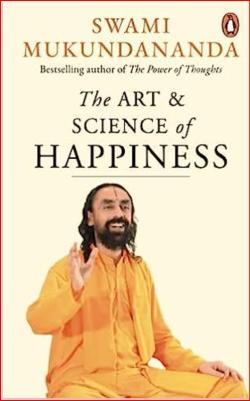
The goal of all humankind is to experience happiness. It is as natural to our constitution as it is to breathe. Many of us attempt to seek happiness by accessing worldly objects that please the five senses of perception. Upon satiation or a general sense of dissatisfaction, we often find ourselves searching for answers to eternal happiness in various aspects of our lives. From relationships to career choices, we seek that elusive state of inner joy and contentment – often without a roadmap. Swami Mukundananda, a renowned spiritual leader and Vedic scholar, offers a roadmap with profound insights into the realms of happiness. In his recently published book, The Art & Science of Happiness, he shares the wisdom that has the power to transform our lives. So, let us embark on this journey to unlock the mysteries of happiness to feel inspired and lead a purposeful life.
While this book presents umpteen knowledge-based concepts and practical wisdom for unlocking true happiness, for the purpose of this blog, we included the ones that appealed to us the most.
The Art & Science of Happiness: Awareness of Our Blessings
Swami Mukundananda explains that our search for happiness is eternal. All souls are parts of the Supreme Lord and as His fragments, we will not be truly happy until we attain Him. He describes the numerous benefits of happiness including increased immunity and speedy recovery from physical illness. He convincingly supports these claims with research findings that convince the reader of the power of their beliefs.
Whether the beliefs are related to physical health or perceived sources of happiness, Swami Mukundananda discusses the power of these beliefs in the context of the Theory of Expectancy. Our beliefs have the power to exercise tremendous control of the mind over the body. If we nurture false beliefs (e.g., happiness lies in material opulence), or operate on the paradigm of what is missing in our lives by making comparisons with others, we will never be happy. However, if we are more grateful for the blessings we have received, we will be happier than ever.
The Art & Science of Happiness: Positive Reframing
Swami Mukundananda explains the negativity bias of our material mind. One of the keys to unlocking lasting happiness is through the power of positive reframing. It is about shifting our perspective and finding the silver lining in every situation. He teaches us how to embrace challenges as opportunities for growth and learning, allowing us to find happiness even in adversity. Drawing from the neurology of happiness, he explains the Tetras effect – neurons that fire together, wire together. It helps us to understand how our brains are wired to seek pleasure and avoid pain. However, he also emphasizes that lasting happiness is not dependent on external circumstances but on our ability to cultivate a positive mindset.
Swami Mukundananda presents some very compelling real-life stories of Anthony Ray Hinton, the man who had been falsely imprisoned, and of the world-famous lawn tennis player Arthur Ashe. They had mastered the art of positive reframing to find happiness in life and overcome all odds. The message is that we should find happiness by becoming the best person we can be and trying to make a difference in the lives of others – Be good, do good, and feel good.
The Art & Science of Happiness: Purposeful Living
Swami Mukundananda explains that the pathway to genuine happiness is purposeful living, finding meaning in life, and aligning actions with our values and goals. All of us have innumerable choices in our pursuit of happiness, however, we need to make wise choices. Many of us tend to choose gratification of our senses for immediate pleasure, resulting in misery later in life.

Described as preya in Vedic literature and hedonia by Greeks, such pleasures do not last long even if we keep on relishing them. In contrast, he describes the advantages of tolerating short-term discomfort for long-term happiness (shreya or eudaimonia respectively).
Pursuing a higher purpose requires all kinds of austerities but it also purifies the mind and uplifts our life. Describing the real-life story of Sindhutai Sapkal, Swami Mukundananda beautifully explains how we can tap into a deep ocean of joy by aligning our actions with a higher purpose in life and serving others selflessly.
The Art & Science of Happiness: Resilience in the Face of Adversity
Even though the entire book is highly inspirational, there is something very profoundly reassuring about how to cultivate resilience in the face of adversity. All of us deal with adversities in life. In fact, adversities are more common when compared to conveniences. The lessons we learn from hardships help us to shape the trajectory of our lives.
Swami Mukundananda presented very compelling stories that indicate how resilience can help to overcome all kinds of odds. For example, Abraham Lincoln experienced failure after failure but it did not discourage him from his goal. Similarly, Abdul Kalam did not let failure block his progress in space research. He persevered until his success shot as high as the rocket itself! There are several such examples that uplift the reader.
Whether adversity comes in the form of physical pain, emotional sorrow, public ridicule, or financial loss, Swami Mukundananda states that it is only after traumatic experiences that post-traumatic growth is possible. The wisdom in these words alone makes this book an excellent treasure. Thus, we must perceive adversities as opportunities to learn and grow because it is only in such situations that knowledge turns into wisdom. Also, “Adversities in life are necessary for the evolution of the soul in its journey toward perfection.” Swami Mukundananda’s words of wisdom enable us to develop the deep spiritual faith needed to accomplish the goal of life.
The Art & Science of Happiness: Nurturing Relationships
One of the key areas Swami Mukundananda explores is the importance of happiness in relationships. He emphasizes that true happiness lies in our ability to foster meaningful connections with others, very much like the symbiotic relationship between certain crops. By understanding what sustains or destroys healthy relationships, we can benefit from his practical wisdom.
The book describes studies involving centenarians that show that a deeper sense of fulfillment is correlated with social bonding, a strong network of social support, feeling valued and a sense of belongingness. Happier relationships also contribute to better physical health and wellness. On the other hand, there are factors that destroy relationships including unrealistic expectations and self-seeking desires.
There are many practical suggestions for strengthening relationships with others. A few of them include building relationships like bank accounts where the ratio of deposits is greater than withdrawals, taking time to understand others before wanting to be understood, and taking responsibility for one’s own happiness. The most thought-provoking of all is that worldly relationships are transient whereas our relationship with God is eternal. If we establish a loving relationship with God, we will find true happiness.

The Art & Science of Happiness: Workplace Flow
Swami Mukundananda addresses the significance of finding happiness in the workplace. He highlights that when we align our passions with our career choices, we tap into “the flow” – a state of intense absorption and focus where the conscious and subconscious mind are aligned. This is when we are the happiest. By cultivating a positive work environment and pursuing tasks that bring us joy, we can unlock our full potential and experience genuine happiness at work. He talks about the importance of selecting a fulfilling career that is challenging yet engaging, related to our competence, has potential for professional growth, adds value to society, and takes care of one’s financial needs.
Among many other practical tips shared by Swami Mukundananda, a few thought-provoking ones include the need to be process-oriented in the workplace, leaving room for feedback, improvement, growth, and satisfaction. He also encourages readers to strive for excellence as opposed to perfection, which may lead to neurosis. Above all, drawing upon Vedic knowledge and wisdom, he suggests the practice of Karm Yog, i.e., dedicating all actions to God and detaching from the results of those actions. This too is the key to true happiness.
The Art & Science of Happiness: Connect with God
Lastly, the book emphasizes the transformative power of connecting with God as a source of ultimate happiness – the divine bliss of God. Swami Mukundananda presents a very profound distinction between Brahmanand (i.e., bliss of the formless aspect of God) and Premanand (i.e., bliss of the exquisite personal form of God). He describes how saints who had already attained Brahmanand, pined for a drop of Premanand after having experienced its bliss. The book ends with the most sublime and inspirational message that gives solace to all readers – strive to cultivate selfless love that has the power to enslave God himself.
Double the Treasure Trove
An excellent accompaniment to this book is the series of YouTube videos on The Art & Science of Happiness with short gems of wisdom by Swami Mukundananda. Listen to these to reinforce the knowledge from the book. Additionally, if you are inspired to get your own copy of the book, you may order it from Amazon: USA or India. Happy reading!
#SwamiMukundananda #Art&ScienceOfHappiness #ArtOfHappiness #ScienceOfHappiness #PositiveReframing #PurposefulLiving #Resilience #Neuroplasticity #ExperienceofFlow #PursuitOfHappiness #UnlockingSecret #ConnectionWithGod #Happiness #HappinessInTheWorkplace #HappinessInRelationships #FacingAdversity #AwarenessOfOurBlessings





